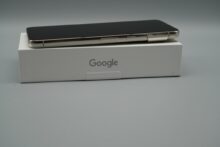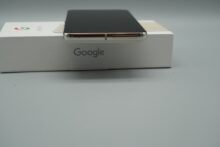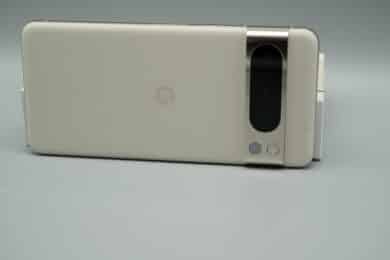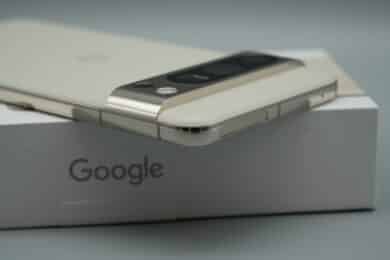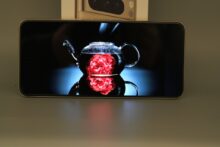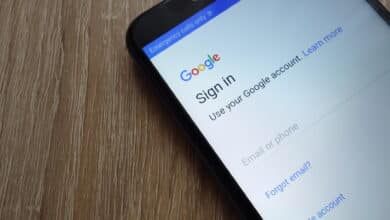
With the Pixel 7 Pro (our test), Google launched a smartphone last year that did not quite reach flagship level, but scored points with innovative AI functions, powerful cameras and a convincing price. The range of functions has been noticeably expanded in the successor and the cameras have been improved. But the price is also considerably higher. Our Google Pixel 8 Pro testclarifies whether it’s worth buying and what the smartphone has to offer.
Technical data
| The product | Google Pixel 8 Pro |
| Processor | Google Tensor G3 |
| CPU |
|
| Operating system | Android 14 |
| Display |
|
| Camera |
|
| Memory | 12 GB LPDDR5 RAM; 128 GB/256 GB/512 GB UFS 3.1 flash memory |
| Network | SIM card slot (nano SIM); eSIM and 5G |
| Connectivity | USB-C 3.2 Gen. 2, Wi-Fi 7 (802.11be), NFC, Bluetooth 5.3 |
| Dimensions and weight | 162.6 mm x 76.5 mm x 8.8 mm (H x W x D); weight: 213g |
| Battery capacity | 5.050 mAh with maximum charging power of 30 watts (wireless up to 23 watts) |
| Colors | Obsidian (black), Bay (blue), Porcelain (beige) |
| Special features | Temperature sensor; AI features; 7 years of updates; secure facial recognition |
| Prices (RRP) | € 899.00 * |
Google Pixel 8 Pro review: design and workmanship
- High-quality and elegant design
- IP68 certification
- Impeccable build quality
The Google Pixel 8 Pro doesn’t look too different from its direct predecessor – at least at first glance. The new top Google model also features the striking camera bar on the back, which holds the three cameras on a strip of polished metal.
The camera unit protrudes around three millimetres beyond the back of the casing, which once again makes the Pixel 8 Pro very wobbly on surfaces – at least when you place it on the back.
In addition to the three cameras, the camera bar has another special feature, as the Pro model has an additional temperature sensor that can be used to measure the temperatures of various surfaces, liquids and materials using a thermometer. Support for measuring body temperatures – which would actually be the most sensible area of application – is probably still to follow. Let’s hope this is really the case.
Let’s stay on the back for a moment: This is now made of a frosted Corning Gorilla Glass Victus 2 and should therefore be quite robust. However, it definitely feels much more grippy than the 7 Pro, which makes for a pleasant feel – but a case for the smartphone is of course still highly recommended.
The camera bar on the back merges seamlessly into the metal frame on the sides, which gives it a classy look. The front continues on a positive note, as the Google Pixel 8 Pro finally has a flat display after its predecessor relied on rounded edges.
On the right-hand side of the device, we find the controls in the form of the power button and a volume rocker positioned below it. In other words, exactly the opposite of almost all other smartphones, which initially takes some getting used to.
However, the buttons offer a pleasant pressure point and are ideally positioned so that they can be reached with one hand. Even I, with my rather small hands, can reach the on/off switch very easily. There’s not much to see on the left, with the exception of the SIM card slot (which accepts a nano SIM).
At the bottom of the Pixel 8 Pro, you will find the USB-C port for charging (USB Type-C 3.2) and the two speakers. With a size of 162.6 mm x 76.5 mm x 8.8 mm, the smartphone is marginally smaller than its predecessor (162.9 x 76.6 x 8.9 mm), but weighs one gram more at 213 grams.
Processing: Pixel 8 Pro is dust and water resistant
Positive: The smartphone is protected against the ingress of dust and water in accordance with IP68. The design of the Google Pixel 8 Pro is once again very elegant and eye-catching – you can tell immediately that it is a Pixel. The new colors look very classy.
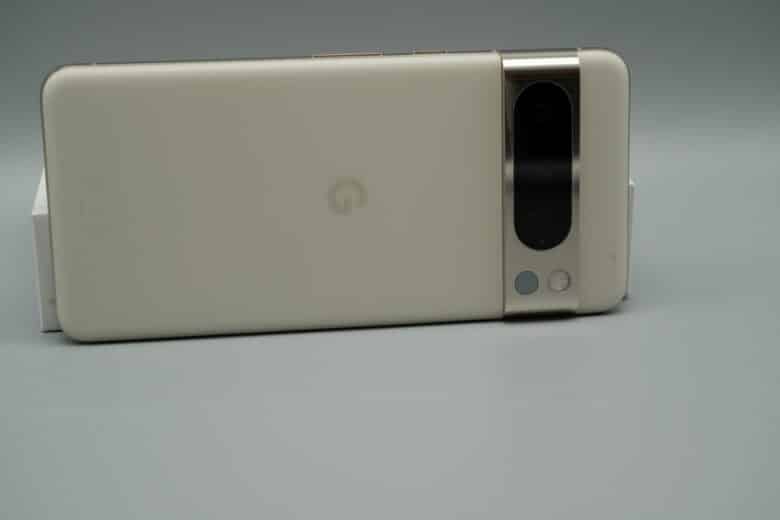
The build quality also leaves nothing to be desired in our test. However, only time will tell whether the problems that the Pixel 7 Pro also suffered from may occur.
The display of the Google Pixel 8 Pro
- Outstanding OLED display
- Impressive peak brightness
- Practical AoD functions
The display of the Google Pixel 8 Pro, which – as already mentioned – now has flat edges, has some new features. Google has installed a 6.7-inch OLED panel, which is interrupted by a punch-hole camera in the middle of the upper edge.
The resolution has been reduced slightly and is now 2,992 x 1,344 pixels, but thanks to LTPO technology, the screen now offers an adaptive refresh rate that can be freely adjusted between 1 Hz and 120 Hertz (depending on the content).
Perhaps the most important new feature of the display, however, is the maximum brightness. The 8 Pro now reaches a whopping 2,400 cd/m² at its peak and 1,600 cd/m² for HDR content. These are outstanding values, thanks to which the smartphone is even positioned ahead of the renowned competition around the iPhone 15 Pro Max and the Galaxy S23 series from Samsung.
In practice, this ensures better readability in brightly lit environments and in direct sunlight. This means that Google currently offers the best smartphone display on the market – not only due to its brightness, but also thanks to its excellent contrast values and color reproduction.
Of course, there is also an always-on display with live displays and “Now Playing” music recognition, which are only available in this form on Pixel devices.
Fingerprint sensor and biometrics of the Google Pixel 8 Pro
- Fast and precise fingerprint sensor
- No ultrasound
- Secure and accurate facial recognition
With the Pixel 6 Pro, the slow and inaccurate fingerprint sensor was one of the biggest points of criticism, which had already been significantly improved in last year’s model. The Pixel 8 Pro (unfortunately) once again does not rely on a fast and precise ultrasonic sensor under the display, as used by Samsung, for example.
Nevertheless, I had no problems unlocking it during my test. With the exception of a few attempts with wet hands, my fingerprints were always recognized quickly and reliably and the smartphone was unlocked.

If you want, you can now also unlock the device using facial recognition. Here, the Pixel 8 Pro is the only current Android device to use a Class 3 security level. This means that payments via Google Pay, logins to banking apps and much more are possible using facial recognition – something that is otherwise only possible with Apple’s FaceID.
Software and AI functions
- Clean, tidy Android 14
- Practical thermometer
- Exciting AI functions
As with its predecessor, Google is focusing on the software and unique AI functions in the Pixel 8 Pro rather than on sheer hardware power. The fact that the built-in Tensor G3 once again cannot compete with the fastest smartphones in terms of performance will be explained later in the Google Pixel 8 Pro test.
Instead, Google relies on a tidy Android 14 interface that comes without bloatware or colorful launchers. There is also an update promise for an incredible seven years of system and security updates.
Sounds great and is certainly meant seriously, but I don’t think there is anyone who really uses their smartphone for seven years. And who knows what technology will be slumbering in the devices in our pockets by then (in 2030).
Thermometer
In addition to the pure Android that Pixel fans appreciate, there is of course a whole range of innovative functions. I have already mentioned the thermometer. This delivers convincing results and confirms, for example, that my coffee is quite hot with a temperature of 51.7 degrees Celsius, but the cup is only very warm at 40.2 degrees Celsius.
This is quite interesting and comes out about the same. However, three measurements at exactly the same position provide two different results that vary by 0.3 degrees Celsius – the thermometer should therefore be seen as an approximate value rather than an exact measurement.
AI background images and more
Another new feature is the option to create background images using artificial intelligence (AI). To do this, we first select a desired design (such as night, structure, landscape and much more) and then – depending on the context – select various prompts that the image should contain.
For example, it could look like this: “Abstract image of mountain (prompt 1) in blue-green (prompt 2) and ice (prompt 3)”. A short time later, the Pixel 8 Pro presents us with two to four generated results, which sometimes match our specifications better and sometimes less well. If we like the result, we can use it as the background image at the touch of a button.
Design fans who like to customize the look of their smartphone should really like this feature. In any case, I think it’s pretty cool.
There are also many other practical AI features that are unique in the smartphone segment. Live translation, for example, allows texts, apps and websites to be displayed in the desired language, which also works in real life thanks to the camera.
The call filter can also recognize and filter out spam calls even better thanks to Google Assistant. The transcription function of the Recorder app, which automatically converts the spoken word into text that can then be saved or copied, has also proven to be practical.
AI functions of the cameras
- Improved magic eraser
- Innovative Magic Editor
- Unique Best Shot function
Most of the AI functions are once again used in conjunction with the cameras. In addition to familiar tools such as the Magic Eraser (which has been noticeably improved), the Pixel 8 Pro also offers new features such as Magic Editor, Best Shot, Face Swap and video enhancement.
For example, you can cut out, reposition and enlarge or reduce objects, animals and people in photos, while the AI uses calculations to try to fit them into the original image as well as possible. This often works quite well in practice, but not always perfectly – Google will probably improve this function over time.
What works very well, however, is Best Shot. If you take several photos with people in them, the heads can be individually adjusted to easily remove closed eyes or grimaces, for example.
Hardware and performance
- Faster and more efficient chip
- Very good everyday performance
- Clearly behind current flagships in games
The Google Pixel 8 Pro once again uses a chip developed in-house by the manufacturer. The Tensor is now in its third generation (Tensor G3) and is now manufactured using the more energy-efficient 4 nm process.
The SoC uses a total of nine computing cores, which are divided into three clusters: A single Cortex-X3 core with up to 2.91 GHz clock speed is combined with four Cortex-A715 cores with up to 2.37 GHz and four efficiency cores in the form of the Cortex-A510 with up to 1.7 GHz clock speed.
In addition, there is an ARM Mali-G715 MP7 graphics unit with 12 GB LPDDR5x memory and 128 GB, 256 GB or 512 GB UFS 3.1 system memory – whereby the chip would even support the faster UFS 4.0 memory. The network is also supported by the Titan M2 security chip, which is responsible for Google’s VPN or the biometric login options. Modern standards such as Wi-Fi 7, Bluetooth 5.3, NFC and an ultra-wideband chip are also included.
In terms of sheer performance, Google once again cannot compete with the fastest chips such as the Snapdragon 8 Gen 2, Apple A17 Pro and similar rivals. This is particularly noticeable in benchmarks and games, where the Tensor G3 has to visibly lose ground.
The good news first: the Pixel 8 Pro has nothing to complain about in terms of everyday performance. The smartphone masters apps, multitasking tasks and demanding 4K videos without any problems and at a convincing working speed. The chip also remains cool during intensive tasks and continuous gaming as well as when charging – Google has therefore managed the problems with heat build-up very well.
In games, however, the smartphone quickly reaches its limits. The benchmark values in 3DMark, Geekbench or PCMark are significantly lower than those of the Snapdragon 8 Gen 2 and Apple A16, although there is a clear increase in performance of 20 to 30 percent compared to the Pixel 7 Pro. An iPhone 14 Pro (our test) from last year also offers significantly better performance.
Means: For demanding games like Genshin Impact, you have to reduce the settings a little. Unfortunately, ray tracing is also not supported, so 3D Mark Solar Bay cannot be started – here, too, the Pixel loses out.
Nevertheless, you can of course play games with the smartphone, but gamers will certainly be happier with other, more powerful devices.
| Benchmark | Pixel 8 Pro |
| PCMark Work 3.0 | 11.875 pts. |
| GeekBench 6 (Single Core) | 1.766 pts. |
| GeekBench 6 (Multi Core) | 4.502 pts. |
| GeekBench 6 (GPU) | 4.961 pts. |
| 3DMark Wild Life | 8.621 pts; 51.62 FPS |
| 3DMark Wild Life Extreme | 2.403 pts; 14.39 FPS |
Good battery life in the Google Pixel 8 Pro
- 050 mAh strong battery
- Slow charging time of around 100 minutes
- Good to very good runtimes
The Google Pixel 8 Pro has a 5,050 mAh battery that can be charged via cable with 30 watts and wirelessly with 23 watts. The corresponding power adapter is not included in the scope of delivery.
This means that Google, like Apple, continues to rely on a rather slow charging speed – the battery charges from 0 to 100 percent in around 1 hour and 40 minutes. The smartphone achieved very good, but by no means outstanding battery life in the test. After use, it takes a few days for the battery to adapt to user behavior – so the battery life improves over time.
In the PCMark Work 3.0 battery life test, the Pixel achieved a runtime of 12 hours and 37 minutes, which is a decent result, but not very meaningful. What I can say in practice: 1 or one and a half days of use are possible without any problems.
I would describe myself as a frequent user and achieve a runtime of around 11 hours with an active display (display-on time). The result is based on mixed use with games, social media, web browsing, YouTube and much more.
This is less than the Samsung Galaxy S23 Ultra (around 13 hours) or iPhone 15 Pro Max (16 hours), but in my opinion it is completely sufficient, although no one should expect a battery miracle. Reverse wireless charging is also offered, which allows other devices to be charged via the smartphone.
The cameras
- Outstanding cameras across the board
- Impressive level of detail
- First-class macro function
Let’s keep it short: Pixel smartphones are known for their outstanding cameras. This also applies to the Google Pixel 8 Pro, which boasts one of the best camera setups in the smartphone segment.
Both the 50 MP main camera and the two 48 megapixel sensors for the ultra-wide angle and the 5x optical zoom deliver outstanding results. In both good and poor lighting conditions.
The leap from 12 MP in the Pixel 7 Pro to 48 MP is particularly noticeable in the ultra wide-angle. Even in difficult lighting conditions, the smartphone captures an impressive amount of detail.
The same applies to the main camera, which shoots at 12 megapixels as standard. Within the camera app, you can select the full 50 MP resolution, which naturally results in significantly larger files. However, the increase in detail is impressive, as the following (zoomed-in) comparison image shows.

Generally speaking, the Pixel 8 Pro takes excellent pictures, regardless of the camera and lighting conditions. The results in macro mode are also impressive and capture the smallest details from a distance of just 2 centimetres. This means you can get much closer to objects and the like than with iPhone and co.
The fewest improvements have been made to the selfie camera. This once again has a resolution of 10.5 megapixels. The aperture of f/2.2 has also remained the same, but compared to the Pixel 7 Pro, there is now autofocus and a slightly larger field of view of 95 degrees compared to 92.8 degrees. The results are good, but by no means outstanding.
Test shots in macro mode:
The Pixel 8 Pro records videos in a maximum of 4K UHD resolution at 60 frames per second – this applies to both the rear cameras and the front camera. The video quality is also impressive, but Google cannot (yet) compete with an iPhone here, even despite Video Boost.
An AI function in the form of the Magic Audio Eraser also comes into play here, which effectively filters out distracting background noise from the video. In practice, this works impressively well.
Google Pixel 8 Pro test: Conclusion
I really liked the Google Pixel 8 Pro in the test. In direct comparison to last year’s model, the current smartphone has improved in all respects. With the exception of the front camera, the camera setup is outstanding across the board and delivers some of the best smartphone photos currently available.
The battery life also increases significantly, but cannot keep up with the best and most efficient devices. For one to one and a half days of use, however, this is easily enough – but it’s about time for a fast charging function.
The biggest weakness is once again the built-in processor. Although the Tensor G3 is once again noticeably faster, the chip only achieves the performance of the upper mid-range, especially in games. However, this is not noticeable in everyday tasks, multitasking, streaming and more – the Pixel 8 Pro runs flawlessly here.
On the other hand, it has the best OLED displays currently on the market and an incomparable update promise. The AI functions are also unique in this form and have been further expanded and significantly improved this year.
However, Google is also charging at least 200 euros more this year – at 1,099 euros upwards, we are clearly at flagship level in terms of price. The Google Pixel 8 Pro is therefore no longer a price-performance tip like its predecessor, but it is a crystal-clear recommendation for anyone for whom software, camera and range of functions are more important than the maximum possible performance.
Google Pixel 8 Pro
Workmanship
Hardware
Multimedia
Performance
Battery
Value for money
93/100
The Google Pixel 8 Pro currently offers the best camera setup and display in the smartphone segment. The innovative AI functions are impressive, but the performance does not reach flagship level. Some competitors also offer more in terms of battery. Nevertheless, the overall package is just right.






